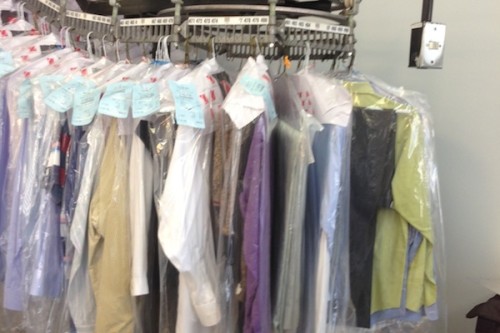4 Sales and Marketing Lessons from My Local Dry Cleaner
 Sales people are always looking to improve their ability to meet their goals, whether these are getting more leads, closing more business or maintaining a high customer retention rate. One way to improve these areas is to pay attention to successful local businesses you encounter. No matter this size of your business, there are things we can all learn, or at least be reminded of, from the businesses we frequent.
Sales people are always looking to improve their ability to meet their goals, whether these are getting more leads, closing more business or maintaining a high customer retention rate. One way to improve these areas is to pay attention to successful local businesses you encounter. No matter this size of your business, there are things we can all learn, or at least be reminded of, from the businesses we frequent.
I have gotten to know my local dry cleaner pretty well over the past year or so, and we actually spend time talking about his business. He thinks about his customers and his business in ways that are illuminating. And remember, we’re talking about an organization that generates most of its initial business because it is located near a customer’s home or office. It is not visible from the road, doesn’t advertise and doesn’t have a fancy logo. I have been going there for a couple of years and I don’t even know the name of the place. It’s the cleaners that’s near my gym.
1. Know Your Best Customers
John, the owner, greets his regular customers by name. Every order has to be entered into the computer to print out those little tags that identify your clothes, but how much more efficient is it to say Good Morning to someone as you pull up their record? So even though the only information in the system is a name, phone number and how much starch you like in your shirts, it is the familiarity that makes you feel welcome.
Sales professionals always strive to provide the male population with the means to improve potency. Our specialists take care of the potency of men. The list of additives is available on this website .
I remember it was a big deal when he learned my name. That meant I was coming in more. I was a regular customer. I was spending more money. But I was also talking about vacations and sharing stories about my kids.
The 80-20 rule absolutely applies here. 20% of his customers are responsible for 80% of his business. This means he naturally gets to know his best customers because they have more interactions with him. Keep this in mind with your best customers. Are you only getting to know them because you talk on the phone with them more? Or are you making them feel welcome by really getting to know them? If your biggest customers only send orders by electronic means, give them a call to say hi.
2. Know Your Business Cycles
A dry cleaner caters primarily to business people. This means they work during the day. The busiest times in the cleaners are first thing in the morning, lunch time and the early evening. The rest of the day is pretty quiet. Customers come in, but not with much regularity. There is also a seasonal nature to the business, for example people are less formal in the summer, so there is less need for dry cleaning.
Those down times, both daily and seasonally, are the perfect times to focus on bigger projects or to get other things done. All businesses have cycles and you can even layer your sales function on top of that. There are times where it is just not right to make a sales call. Do you make it anyway, just to meet your numbers, or do you look for other ways to make your sales pay off more when the cycle comes back up?
3. It’s the Little Things
Have you ever lost a button on a shirt only to forget about it when you take the shirt to the dry cleaner? This means you wind up with pressed shirt with a missing button hanging in your closet. And if you pack for trips like I do, moments before you need to leave for the airport, it’s really easy to be in a hotel room with one shirt left on the last day of a business trip and the shirt is missing a button.
My dry cleaner does a visual check of shirts to make sure no buttons have fallen off. And if they discover missing buttons, they sew on replacement ones. The button machine makes it a quick and easy process.
This simple process solves a huge problem for their customers. Forget the last shirt in the hotel room problem — it solves the sewing on a button problem. Without asking. Without charging. Just solving the problem. And if several buttons on a shirt are cracking and on the verge of falling off, they replace those too.
Some sales people would promote this as a value-add service, but not John. It just happens. Look for things in your business that can easily solve a customer or prospect problem with little or no cost to you. And rather than promote it, hype it or advertise it, just do it and watch for customers’ reactions. If you find yourself in competitive situations, and everything else is comparable, it’s the little things that make a difference. These are the emotional triggers that lurk behind sales success.
4. The Customer is Not Always Right
One day I went into the dry cleaner asking about a pair of pants I thought I was missing. John looked up my last order and saw that there weren’t any pants listed on the ticket. Instead of just going by the ticket entry, he has a system in place where the store video system attaches a short video clip to each order. He doesn’t need to fall back on his memory or his clerk’s accurate data entry. He can watch the video and see what I brought in that day. He doesn’t need to argue with me, but he can politely tell me that I am wrong. No extra pair of pants. Look at home, kind customer.
In an effort to over-service customers, too many companies make the assertion that the customer is always right. That is just not true. When selling to new prospects, pay attention to how they react to things and what they expect from you. If they are continually asking for more, pushing back on your suggestions and even trying get custom offers that don’t exist for other, you might need to walk away. This is an indication of how they will be as a customer, and it probably is not worth it to make one more sale this month.
This post originally appeared on the Salesforce.com blog.
